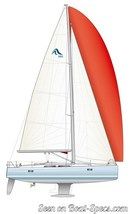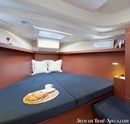Hanse 385 Standard
Sailboat specifications
The Hanse 385 is a 35’10” (10.9m) cruising sailboat designed by Judel/Vrolijk (Germany). She was built between 2011 and 2017 by Hanse (Germany).
The Hanse 385 is as well listed, on Boat-Specs.com, in Shoal draft version (see all the versions compared).
The Hanse 385 is as well listed, on Boat-Specs.com, in Shoal draft version (see all the versions compared).
Hanse 385's main features
- Model
- Hanse 385
- Version
- Standard
- Hull type
- Monohull
- Category
- Cruising sailboat
- Sailboat builder
- Sailboat designer
- Country
- Germany
- Construction
- GRP (glass reinforced polyester):
- Hull: Single skin fiberglass polyester
- Deck: Sandwich balsa fiberglass polyester - First built hull
- 2011
- Last built hull
- 2017
- Appendages
- Keel : T-shaped keel (with bulb)
- Helm
- Twin helm wheels
- Rudder
- Single spade rudder
- Unsinkable
- No
- Trailerable
- No
- EC design categoryiThe CE design category indicates the ability to cope with certain weather conditions (the sailboat is designed for these conditions)
A: Wind < force 9, Waves < 10m
B: Wind < force 8, Waves < 8m
C: Wind < force 6, Waves < 4m
D: Wind < force 4, Waves < 0,5m - A
- Standard public price ex. VAT (indicative only)
- About121 000 €(2016)
Hanse 385's main dimensions
- Overall length
- 37’ 5”11.4 m
- Hull length
- 35’ 10”10.9 m
- Waterline length
- 34’ 1”10.4 m
- Beam (width)
- 12’ 8”3.88 m
- Draft
- 6’ 6”1.99 m
- Mast height from DWL
- 56’ 10”17.3 m
- Light displacement (MLC)
- 16755 lb7600 kg
- Ballast weight
- 4850 lb2200 kg
- Ballast type
- Cast iron
Hanse 385's rig and sails
- Upwind sail area
- 834 ft²77.5 m²
- Mainsail area
- 474 ft²44 m²
- Solent area
- 361 ft²33.5 m²
- Jib area
- 323 ft²30 m²
- IiFore triangle height (from mast foot to fore stay top attachment)
- 48’ 2”14.7 m
- JiFore triangle base (from mast foot to bottom of forestay)
- 14’ 1”4.3 m
- PiMainsail hoist measurement (from tack to head)
- 45’ 11”14 m
- EiMainsail foot measurement (from tack to clew)
- 16’ 8”5.1 m
- Rigging type
- Sloop Marconi 9/10
- Mast configuration
- Deck stepped mast
- Rotating spars
- No
- Number of levels of spreaders
- 2
- Spreaders angle
- Swept-back
- Spars construction
- Aluminum spars
- Standing rigging
- 1x19 strand wire
Hanse 385's performances
- Upwind sail area to displacementiThe ratio sail area to displacement is obtained by dividing the sail area by the boat's displaced volume to the power two-thirds.
The ratio sail area to displacement can be used to compare the relative sail plan of different sailboats no matter what their size.
Upwind: under 18 the ratio indicates a cruise oriented sailboat with limited performances especially in light wind, while over 25 it indicates a fast sailboat. - 216 ft²/T20.05 m²/T
- Displacement-length ratio (DLR)iThe Displacement Length Ratio (DLR) is a figure that points out the boat's weight compared to its waterline length. The DLR is obtained by dividing the boat's displacement in tons by the cube of one one-hundredth of the waterline length (in feet).
The DLR can be used to compare the relative mass of different sailboats no matter what their length:
a DLR less than 180 is indicative of a really light sailboat (race boat made for planning), while a DLR greater than 300 is indicative of a heavy cruising sailboat. - 191
- Ballast ratioiThe Ballast ratio is an indicator of stability; it is obtained by dividing the boat's displacement by the mass of the ballast. Since the stability depends also of the hull shapes and the position of the center of gravity, only the boats with similar ballast arrangements and hull shapes should be compared.
The higher the ballast ratio is, the greater is the stability. - 29 %
- Critical hull speediAs a ship moves in the water, it creates standing waves that oppose its movement. This effect increases dramatically the resistance when the boat reaches a speed-length ratio (speed-length ratio is the ratio between the speed in knots and the square root of the waterline length in feet) of about 1.2 (corresponding to a Froude Number of 0.35) . This very sharp rise in resistance, between speed-length ratio of 1.2 to 1.5, is insurmountable for heavy sailboats and so becomes an apparent barrier. This leads to the concept of "hull speed".
The hull speed is obtained by multiplying the square root of the waterline length (in feet) by 1.34. - 7.83 knots
Hanse 385's auxiliary engine
- Engine(s)
- 1 inboard engine
- Engine(s) power
- 27 HP
- Fuel type
- Diesel
- Fuel tank capacity
- 42.3 gal160 liters
Hanse 385's accommodations and layout
- Cockpit
- Closing aft cockpit with opening system
- Cabin(s) (min./max.)
- 2 / 3
- Berth(s) (min./max.)
- 4 / 8
- Head(s)
- 1
- Freshwater tank capacity
- 79.3 gal300 liters
- Fridge/ice-box capacity
- 34.3 gal130 liters
- Maximum headroom
- 6’ 2”1.9 m










Hanse 385 interior and accommodations - - 9/11
Picture extracted from the commercial documentation © Hanse
Picture extracted from the commercial documentation © Hanse


Hanse 385 interior and accommodations - - 10/11
Picture extracted from the commercial documentation © Hanse
Picture extracted from the commercial documentation © Hanse


Hanse 385 interior and accommodations - - 11/11
Picture extracted from the commercial documentation © Hanse
Picture extracted from the commercial documentation © Hanse
Similar sailboats that may interest you:
Sailboats
First built hull
Hull length
2012
39’ 4”11.99 m
2014
35’ 10”10.9 m
2011
39’ 4”11.99 m
2009
36’ 1”11 m
2017
36’ 1”10.99 m
2018
36’ 8”11.19 m
2015
29’ 11”9.1 m
2012
32’ 10”9.99 m
2010
35’ 10”10.9 m
2011
35’ 10”10.9 m
2014
36’10.96 m
2013
36’ 6”11.13 m
2010
37’ 2”11.35 m
2010
39’ 4”11.99 m
2006
39’ 4”11.99 m